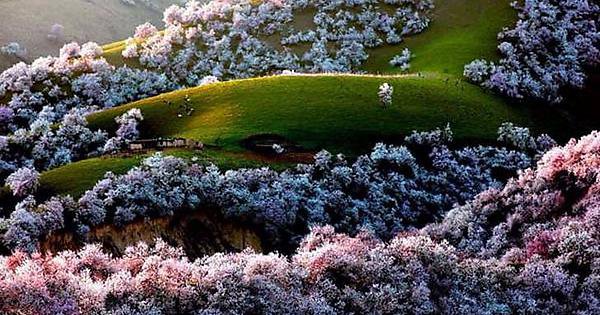Kazakhstan – Motherland of Apples

Motherland of Apples
Silk Road travelers, trading their goods and ideas across Eurasia, brought with them hitchhiking apple seeds, discarded from the choicest fruit pulled from wild trees. This early selection would eventually lead to the 7,500 varieties of apple that exist today.
It might seem strange to think that the common apple was not originally a universal fruit, but in fact it has its roots in one specific region of the world.
Malus Sierversii grows in Tian Shan, Kazakhstan
The ancestor of the domestic apple is the Malus sieversii, which grows wild in the Tian Shan Mountains of Kazakhstan.
Nikolai Vavilov first traced the apple genome
In the early 20th century, biologist Nikolai Vavilov first traced the apple genome back to a grove near Almaty, a small town. He visited Almaty and was astounded to find apple trees growing wild, densely entangled and unevenly spaced, a phenomenon found nowhere else in the world.
Can be a $50 billion industry for Kazakhstan
The survival of the original apple is not a mere historical footnote. Experts believe that Kazakhstan’s primeval forests may one day help to save the $50 billion per year global apple industry.
Tian Shan apple seeds were transported by birds and bears
Scientists believe the Tian Shan apple seeds were first transported out of Kazakhstan by birds and bears long before humans ever cultivated them.
Malus Sieversii had already taken root in Syria
By the time humans did begin to grow and trade apples, the Malus sieversii had already taken root in Syria. The Romans discovered it there, and dispersed the fruit even further around the world.
Almaty and its surrounding is the origin of all apples
When modern genome sequencing projects affirmatively linked domestic apples to Malus sieversii, Almaty and its surrounding land were officially recognized as the origin of all apples.
Almaty means “Father of Apples”
Almaty means “father of apples,” and the town touts its heritage proudly. A fountain in the center of town is apple-shaped, and vendors come out each week to sell their many varieties of domesticated apples at market.
Malus sieversii is a deciduous tree growing to 10m, with a very similar appearance to the domestic apple.
The leaves are green and ovate and unlike other domesticated varieties the leaves go red in autumn. Flowers are 3cm in diameter and pinkish, tinged rose when in bud, the fruit is yellowish green, tinged red and up to 7cm in diameter.
Apple diseases are a rarity in the never-cultivated trees of the Tien Shen, where a plethora of apple genes developed over several thousand years of isolation from the rest of the world’s apples.
Today, experts are looking for apple salvation in the forests here, which are vigorously defended by Mr. Jangaliyev, Kazakhstan’s pre-eminent apple expert. “This is a unique resource for the planet,” says Herb Aldwinckle, an apple expert at Cornell University, the main U.S. repository of apple knowledge. “We have found that the native apples of Kazakhstan have a wealth of disease resistance,” he says.
These naturally occurring groves to be “a marvelous garden where apples and pears look down on you from the trees and beg to be eaten.”
Within this region of Kazakhstan, experts have catalogued more than fifty-six wild forms of Malus sieversii, twenty-six of which might be called the basic wild ecotypes, with the other thirty being natural or anciently semi domesticated hybrids.
That is scientific shorthand for saying that for thousands of years, forest dwellers have influenced the diversity of these “wild forests,” selecting flavors, textures, and qualities that persist in self-seeding or feral trees to this day.
As the apple traveled west along the Silk Road in the hands of travelers, trees grew from dropped seeds and crossed with sour wild crabapples.
The authors found that the European crabapple, Malus sylvestris contributed so extensively to the apple’s genome that the modern apple is more similar to this sour crabapple than to the Kazakhstani ancestor, Malus sieversii.
The hybridization between ancient cultivated apples and M. sylvestris, followed by extensive human selection, produced larger apples that are fuller in flavor, crispier, and firmer, giving them a longer shelf life.
Experts explain, “The modern domesticated apples have higher and well-balanced sugar and organic acid contents. That is how the apple started to become a popular and favored fruit.”
In most cases of fruit domestication, the wild ancestor has tiny fruit that was shaped into its large, nutritious cultivated counterpart through centuries of selection. For example, the domesticated tomato is at least 100 times larger than its wild relatives.
“This is not quite the case for apple,” expert said. “It’s domestication started with a medium to large-sized fruit.”
Comparing the different apple genomes, the researchers found evidence supporting two evolutionary steps contributing to apple’s size increase—one before and one after domestication.
The large size of wild Malus sieversii gave it an advantage. Having already evolved to a suitable size before cultivation, it was more attractive to growers who would not need to spend much effort selecting for larger fruits.
Such a lack of size selection also means that the genes responsible for size increase still retain variability with potential for future selection.
The researchers identified several size-associated genetic markers, which is great news for breeders who want to further increase the apple’s girth.





